Nixeus VUE 30: 30" 2560x1600 IPS Monitor Review
by Chris Heinonen on August 20, 2013 6:00 AM ESTLarge panels seem to do better with our advanced uniformity testing, and the Nixeus does quite well overall here. There is an issue with some lack of light at the very top of the display, but overall most of the display is very even and uniform when compared to the center. White Uniformity is very good overall. That top row causes some issues, but the rest of the screen is very good. There isn’t anything bad to say about it aside from the very top and I didn’t notice that in daily work.
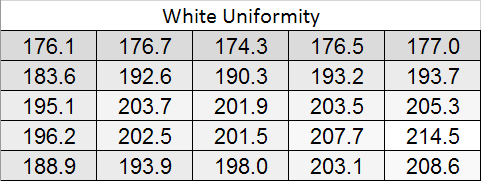

Black Uniformity is very similar. It has a drop in black level at the top, just like white does, but the rest of the screen is pretty accurate when compared to the center calibration target.
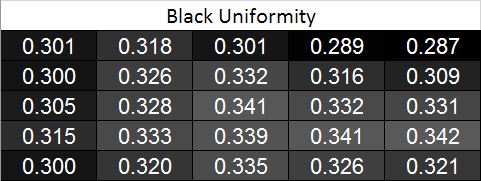
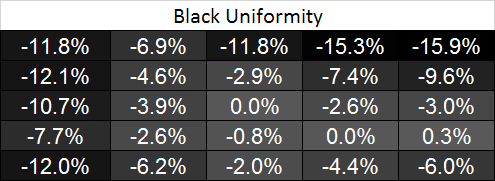
Since both White and Black have issues in the same screen areas, we wind up with a very uniform screen for our contrast ratio. It does dip down a little bit at a couple edges and corners, but most of the screen is +/- 5% when compared to center.
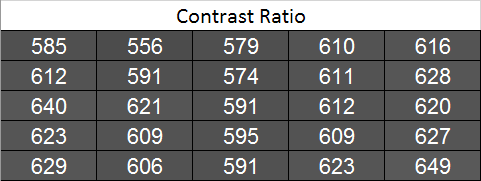

Our dE2000 errors compared to center are very good except for that top row. The lighting issue there causes a high level of error when compared to the rest of the screen, though the errors barely creep up into the visible level at the worst areas. The center of the screen is very good and would work really well for photo editing and other tasks. This makes the lack of a good sRGB mode even worse, as the good uniformity of the display would make it a nice choice for doing color critical work, but the poor gamut results make that a less likely use for it (though of course professional apps are the most likely to support the AdobeRGB color space).
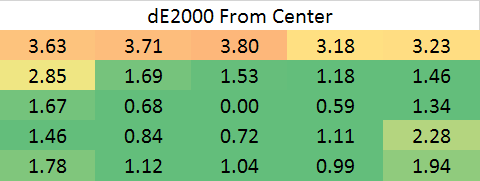
For everyone else, the display itself is very uniform except for a slightly darker area at the top. The bottom-right corner measured slightly hot, but the light bleed there was only noticeable on a pure-black screen if I was really looking for it. Otherwise the amount of light leakage is so low as to not cause a problem.










95 Comments
View All Comments
blackoctagon - Tuesday, August 20, 2013 - link
Glad to hear you're so insensitive to input lag. However, what you experience is by no means the cream of the crop. One can maintain the pleasant colours of IPS and still have good motion clarity by getting one of the overclockable 27-inch 1440p screens. Their input lag is much less, and further mitigated by the (approx.) 120Hz refresh rate. Orders of magnitude better for FPS gaming than what a 30-inch IPS screen can deliverDanNeely - Tuesday, August 20, 2013 - link
The 2408 was infamously bad. Unlike previous laggy Dell panels that only bothered some gamers the 2408 was slow enough that it annoyed a lot of people who were just working at the desktop. While continuing to insist nothing was wrong and it was working as designed; Dell/etc pulled back (and eventually started listing it on their spec sheets) and the display industry generally insisted on nothing slower than ~2 frames (32ms) which are good enough that no one other than some action gamers complain. I occasionally notice what might be the 30ms on my NEC 3090 when playing POE (an aRPG); but it's intermittent enough I'm not sure if it's actually panel lag or just me hitting the limits of my reaction time.ZeDestructor - Tuesday, August 20, 2013 - link
>overclockable 27-inch 1440p screensRPS or bit-tech (can't remember which) tested that when the Titan came out. They only achieved ~72Hz before the panel itself just started dropping frames because it couldn't keep up.
Besides, as I said up there, image processing and DP->LVDS conversion takes time. constant time, but time nonetheless. If you had a TN panel at 2560x1600@60Hz, you'd see at least 12ms of processing lag + some more for the panel itself. If you can rip out the on-board processing entirely, you're reducing the lag quite a a bit, which is exactly what game modes do: pipe the signal straight to LVDS conversion with no post-processing. On the U2410, that drops the latency from ~30ms to ~14ms.
In any case, you missed the point of my comment, where I mentioned it being in the same range as most other wide-gamut, professional-use panels and perfectly fine for single-player gaming, where you can learn to compensate for it. Hell, my LoL-playing friends used to pull off skillshots by timing it just right with a a 300ms ping time to US servers. If you think 30ms is bad...
blackoctagon - Tuesday, August 27, 2013 - link
I would like to see this "RPS or bit-tech" review if you can find it. There are plenty of 2560x1440 monitors out there that overclock SLIGHTLY, but VERY few that support refresh rates up to approx. 120Hz. Unless the reviewers looked at one of the latter monitors (which would surprise me) then I'm not surprised that they started seeing dropped frames.davsp - Tuesday, August 20, 2013 - link
Viewable Size = 20" I'm guessing typo on spec sheet. :)ingwe - Tuesday, August 20, 2013 - link
Nah, didn't you see the HUGE bezel?ZeDestructor - Tuesday, August 20, 2013 - link
> Note also that lag might be lower running at the native 2560x1600, but I can't directly compare that with most other displays as they lack support for that resolution.Please don't do that. People who buy/want these big, 30" 16:10 panels are paying the hefty premium for the full resolution, not to run something lower through the scaler. As such, I (and others, probably) would appreciate native resolution response times rather than scaled. 2560x1600 is uncommon because of the hefty price (1.5k per screen so far!), not because wqe don't want 2560x1600.
JarredWalton - Tuesday, August 20, 2013 - link
I believe Chris is using a Leo Bodnar device now (http://bit.ly/WXV7Vv), where formerly he used a CRT as a reference display sending the same content to both. To do native 2560x1600 lag tests, you'd need a device (CRT or Leo Bodnar or similar) that supports WQXGA...which doesn't exist. Chris can correct me if I'm wrong, though.saratoga3 - Tuesday, August 20, 2013 - link
Apparently that device can't do > 1080p. Unfortunately this means using the scaler, which I think is a really bad idea. Resizing a 4 MP image can easily take an entire frame worth of latency. Its entirely possible that the actual input lag at native resolution is much lower.mdrejhon - Wednesday, August 21, 2013 - link
The Blur Busters Input Lag Tester, supports 4K, 120Hz, WQXGA and any other resolutions. It will be released before the end of the year. There is also a second input lag tester (SMTT style) that I have invented as well, which is undergoing tests. Keep tuned at the Blur Busters website.